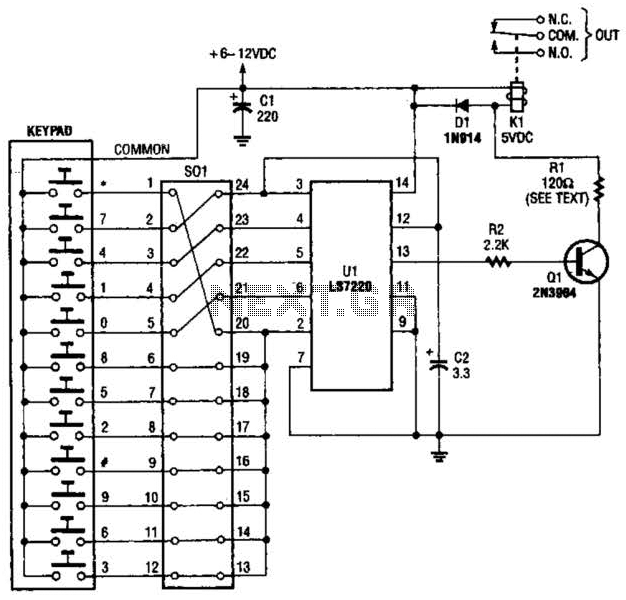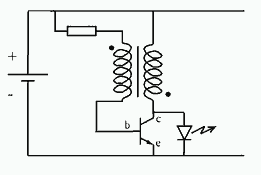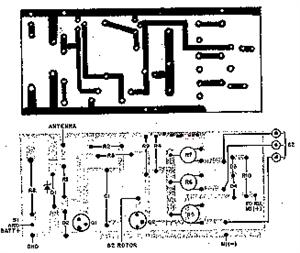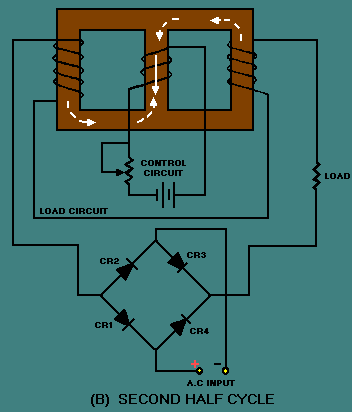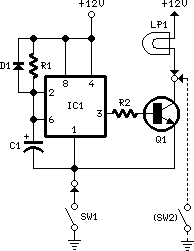
Lamp-Switching Circuit Circuit
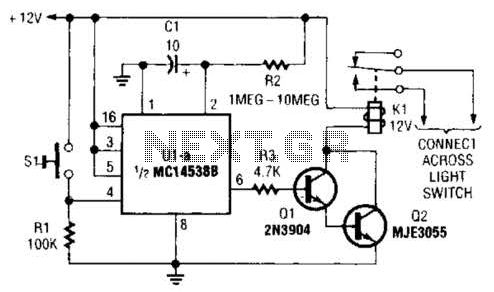
A normally open pushbutton switch (SI) provides a positive input pulse to pin 4 of U1, activating the integrated circuit (IC). The output from U1 at pin 6 delivers base-drive current to a Darlington pair consisting of Q1 and Q2, which activates a timing capacitor and allows the use of any resistor value ranging from 1 to 10 ohms as timing components. To implement this circuit for controlling a vehicle's headlights, connect the relay's normally open contacts in parallel with the car's headlight switch, and press SI to increase the duration of the headlights being on. Additionally, when connecting the circuit to control an AC-operated lamp, ensure that the AC power is turned off and connect the relay contacts in parallel with the lamp's power switch contacts.
The circuit described utilizes a normally open pushbutton switch (SI) to initiate a timing sequence through an integrated circuit (IC) designated as U1. Upon pressing the switch, a positive pulse is sent to pin 4 of U1, which triggers the operation of the IC. The output at pin 6 of U1 is responsible for providing base-drive current to a Darlington pair formed by transistors Q1 and Q2. This configuration is advantageous for amplifying current, allowing for the control of larger loads like relays or motors.
The timing components of the circuit, which include a capacitor and a resistor, play a critical role in determining the duration for which the output remains active. The circuit design permits flexibility in selecting resistor values between 1 to 10 ohms, while the capacitor value can be adjusted to achieve the desired timing characteristics. This feature is particularly useful for applications requiring specific on durations.
For automotive applications, the circuit can be applied to control the headlights of a vehicle. By connecting the relay's normally open contacts across the existing headlight switch, the circuit allows the headlights to remain illuminated for a longer period upon pressing the pushbutton switch (SI). This is particularly useful for scenarios where the driver may need to keep the headlights on for an extended duration after exiting the vehicle.
In an alternative application for controlling an AC-operated lamp, the circuit can be integrated with the lamp's power switch. It is crucial to ensure that the AC power is turned off before making any connections to avoid electrical hazards. The relay contacts should be connected in parallel with the lamp's power switch contacts. This setup allows the pushbutton switch (SI) to control the lamp's operation, providing a convenient method for turning the lamp on and off with a timed delay.
Overall, this circuit design offers versatility in controlling various electrical loads while providing a simple user interface through the pushbutton switch. A normally open pushbutton switch (SI) delivers a positive input pulse to pin 4 of Ul, triggering the 1C into action. The output of Ul at pin 6 supplies base-drive current to a Darlington pair comprised of Q1 and Q2, activating .
10- capacitor and any resistor value of from 1 to 10 can be used as the timing components.To use the circuit on an auto`s headlights, connect the relay`s normally open contacts across the car`s headlight switch and press SI to extend the on time. In connecting the circuit to control an ac-operated lamp, turn off the ac power and connect the relay contacts in parallel with the lamp`s power switch contacts. 🔗 External reference
The circuit described utilizes a normally open pushbutton switch (SI) to initiate a timing sequence through an integrated circuit (IC) designated as U1. Upon pressing the switch, a positive pulse is sent to pin 4 of U1, which triggers the operation of the IC. The output at pin 6 of U1 is responsible for providing base-drive current to a Darlington pair formed by transistors Q1 and Q2. This configuration is advantageous for amplifying current, allowing for the control of larger loads like relays or motors.
The timing components of the circuit, which include a capacitor and a resistor, play a critical role in determining the duration for which the output remains active. The circuit design permits flexibility in selecting resistor values between 1 to 10 ohms, while the capacitor value can be adjusted to achieve the desired timing characteristics. This feature is particularly useful for applications requiring specific on durations.
For automotive applications, the circuit can be applied to control the headlights of a vehicle. By connecting the relay's normally open contacts across the existing headlight switch, the circuit allows the headlights to remain illuminated for a longer period upon pressing the pushbutton switch (SI). This is particularly useful for scenarios where the driver may need to keep the headlights on for an extended duration after exiting the vehicle.
In an alternative application for controlling an AC-operated lamp, the circuit can be integrated with the lamp's power switch. It is crucial to ensure that the AC power is turned off before making any connections to avoid electrical hazards. The relay contacts should be connected in parallel with the lamp's power switch contacts. This setup allows the pushbutton switch (SI) to control the lamp's operation, providing a convenient method for turning the lamp on and off with a timed delay.
Overall, this circuit design offers versatility in controlling various electrical loads while providing a simple user interface through the pushbutton switch. A normally open pushbutton switch (SI) delivers a positive input pulse to pin 4 of Ul, triggering the 1C into action. The output of Ul at pin 6 supplies base-drive current to a Darlington pair comprised of Q1 and Q2, activating .
10- capacitor and any resistor value of from 1 to 10 can be used as the timing components.To use the circuit on an auto`s headlights, connect the relay`s normally open contacts across the car`s headlight switch and press SI to extend the on time. In connecting the circuit to control an ac-operated lamp, turn off the ac power and connect the relay contacts in parallel with the lamp`s power switch contacts. 🔗 External reference
